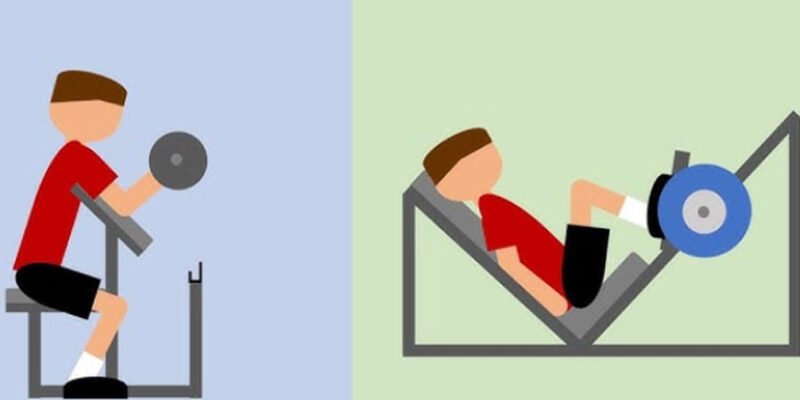Free weights are a popular choice for those looking to build muscle and improve their overall fitness. While many people use them regularly, few understand the science behind how they impact muscle activation and growth. In this article, we will explore the science behind free weights and how they can help you achieve your fitness goals.
When it comes to building muscle, free weights are a highly effective tool. Unlike machines,which often restrict movement to a single plane, free weights allow for a greater range of motion and engage more muscle fibers during exercise. This increased muscle activation can lead to greater muscle growth over time.
However, not all free weights are created equal. Different types of exercises and weights can impact muscle activation and growth in different ways. Understanding these differences can help you design a more effective workout routine and achieve better results. In the following sections, we will explore the science behind free weights and how you can use this knowledge to optimize your workouts.
The Science of Muscle Activation
Understanding the science behind muscle activation is crucial to comprehending the impact of free weights on muscle growth. The neuromuscular response and motor unit recruitment are two essential aspects of muscle activation that play a vital role in muscle growth.
Neuromuscular Response
The neuromuscular response is the communication between the nervous system and the muscles. When a person lifts a weight, the nervous system sends signals to the muscles,initiating muscle contraction. The neuromuscular response is essential in activating the muscles
and increasing muscle strength.
Motor Unit Recruitment
Motor unit recruitment is the process of activating muscle fibers within a muscle. The motor unit consists of a motor neuron and the muscle fibers it innervates. The more motor units recruited,the more muscle fibers are activated, resulting in increased muscle strength and growth.
Research has shown that free weights activate more motor units than machines. Free weights require the activation of stabilizing muscles, resulting in the recruitment of more motor units. In contrast, machines provide stability, resulting in the activation of fewer motor units.
In conclusion, understanding the science behind muscle activation is essential to comprehend the impact of free weights on muscle growth. The neuromuscular response and motor unit recruitment are two critical aspects of muscle activation that play a vital role in muscle growth.
The Role of Free Weights in Muscle Growth
Free weights have been a staple in strength training for decades, and for good reason. They are versatile, effective, and provide numerous benefits for muscle growth. In this section, we will explore the role of free weights in muscle growth and why they are a valuable tool for anyone looking to build strength and muscle mass.
Resistance and Progressive Overload
One of the primary reasons free weights are so effective for muscle growth is their ability to provide resistance and progressive overload. When you lift weights, you create tension in your muscles, which stimulates muscle fibers to grow and adapt. Free weights allow you to increase resistance gradually, making it easier to achieve progressive overload, which is essential for
muscle growth.
Compound Movements and Muscle Stimulation
Another benefit of free weights is their ability to stimulate multiple muscle groups simultaneously. Compound movements, such as squats, deadlifts, and bench press, are excellent examples of exercises that engage multiple muscle groups at once. By incorporating these exercises into your training routine, you can maximize muscle stimulation and growth.
Additionally, free weights allow for a greater range of motion and flexibility in your workouts. This increased range of motion can help you target specific muscle groups more effectively and improve overall muscle activation.
In summary, free weights are an essential tool for anyone looking to build strength and muscle mass. By providing resistance and progressive overload, as well as stimulating multiple muscle groups simultaneously, free weights are a valuable addition to any training routine.
Comparing Free Weights and Machine Weights
When it comes to weightlifting, there are two main types of equipment: free weights and machine weights. Both types of equipment have their pros and cons, and it’s important to understand the differences between them to make an informed decision about which type of equipment to use.
Range of Motion
One of the main differences between free weights and machine weights is the range of motion they allow. Free weights, such as dumbbells and barbells, allow for a greater range of motion because they are not restricted by a fixed movement pattern. This means that the lifter can move the weight in a way that feels natural and comfortable, which can help to activate more muscle fibers and increase overall muscle growth.
On the other hand, machine weights are designed to follow a fixed movement pattern, which can limit the range of motion. While this can be beneficial for beginners who need to learn proper form and technique, it may not be ideal for more advanced lifters who want to target specific muscles and movements.
Stability and Balance
Another difference between free weights and machine weights is the level of stability and balance required. Free weights require more stability and balance because the lifter must control the weight throughout the entire range of motion. This can help to strengthen the stabilizing muscles and improve overall balance and coordination.
Machine weights, on the other hand, provide more stability and support because the weight is fixed in place. This can be beneficial for beginners or those with injuries who need extra supportand stability.
In summary, both free weights and machine weights have their advantages and disadvantages.Free weights allow for a greater range of motion and require more stability and balance, while machine weights provide more stability and support. Ultimately, the choice between free weights and machine weights will depend on the lifter’s goals, experience level, and personal preferences.
Safety and Proper Form with Free Weights
When it comes to using free weights for strength training, safety and proper form are essential to prevent injury and optimize performance. In this section, we will discuss some tips on how to use free weights safely and effectively.
Avoiding Injury
Injuries can occur when using free weights if proper form is not maintained or if the weight is too heavy. Some common injuries include strains, sprains, and even fractures. Here are some tips to avoid injury:
- Start with a weight that is comfortable and manageable, and gradually increase the weight as strength improves.
- Always warm up before lifting weights to increase blood flow and reduce the risk of injury.
- Use proper form and technique when lifting weights. This includes maintaining a neutral spine, keeping the core engaged, and avoiding jerky or sudden movements.
- Use a spotter when lifting heavy weights to ensure safety and proper form.
Optimizing Performance
Proper form not only helps prevent injury but also optimizes performance. Here are some tips to help improve performance:
- Focus on the muscle group being worked and maintain proper form throughout the exercise.
- Use a full range of motion when lifting weights to engage more muscle fibers and improve overall strength.
- Incorporate variations in exercises and weights to prevent plateaus and challenge the body in new ways.
- Rest adequately between sets to allow for muscle recovery and growth.
By following these tips, individuals can safely and effectively use free weights for strength training and achieve their fitness goals.
Case Studies on Free Weights and Muscle Activation
Several studies have been conducted to investigate the impact of free weights on muscle activation and growth. Here are a few noteworthy case studies:
Case Study 1: Barbell Deadlift vs. Smith Machine Deadlift
In a study conducted by Schick et al. (2010), the barbell deadlift and the Smith machine deadlift were compared in terms of muscle activation. The results showed that the barbell deadlift produced significantly greater muscle activation in the gluteus maximus, erector spinae, and vastus lateralis muscles compared to the Smith machine deadlift. This suggests that the barbell
deadlift may be a more effective exercise for targeting these muscles.
Case Study 2: Dumbbell Bench Press vs. Smith Machine Bench Press
In another study by Saeterbakken et al. (2011), the dumbbell bench press and the Smith machine bench press were compared in terms of muscle activation. The results showed that the dumbbell bench press produced significantly greater muscle activation in the pectoralis major,anterior deltoid, and triceps brachii muscles compared to the Smith machine bench press. This suggests that the dumbbell bench press may be a more effective exercise for targeting these muscles.
Case Study 3: Barbell Squat vs. Leg Press
A study by Andersen et al. (2018) compared the barbell squat and the leg press in terms of muscle activation. The results showed that the barbell squat produced significantly greater muscle activation in the gluteus maximus, vastus lateralis, and biceps femoris muscles compared to the leg press. This suggests that the barbell squat may be a more effective exercise for targeting these muscles.
Overall, these case studies suggest that free weights may provide greater muscle activation compared to machine-based exercises. However, it is important to note that individual differences in anatomy and training status may impact the effectiveness of different exercises for different individuals.
Conclusion
Free weights have been shown to be highly effective in activating muscle fibers and promoting muscle growth. By allowing for greater range of motion and requiring more stabilization, free weights engage more muscle groups and promote greater overall strength and fitness than machines or other forms of exercise.
When using free weights, it is important to use proper form and technique to avoid injury and ensure maximum effectiveness. Beginners should start with lower weights and focus on proper form before increasing weight or intensity.
In addition to traditional free weight exercises such as squats, deadlifts, and bench press, there are a variety of other exercises that can be performed with free weights, including kettlebell swings, dumbbell snatches, and more.
Overall, incorporating free weights into a fitness routine can have numerous benefits for muscle activation and growth. By using proper form and gradually increasing weight and intensity,individuals can achieve their fitness goals and improve overall health and wellness.
















Comments